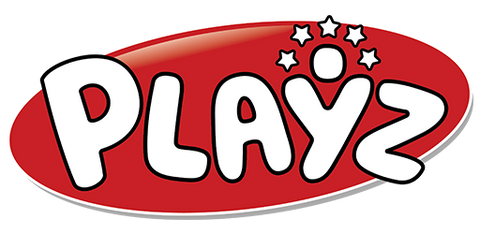
The Ultimate Guide to the Best Educational Toys for Preschoolers
The best toys for preschoolers are the ones that don't do all the work. They’re open-ended, sparking a child’s natural curiosity and inviting them to solve problems, get creative, and build crucial motor skills. A simple set of wooden blocks isn't just wood; it's a hands-on lesson in engineering, physics, and storytelling. This is how simple playtime transforms into a powerful learning experience.
What Makes a Toy Genuinely Educational?
In a world packed with flashy gadgets, it’s easy to get lost in marketing hype. So, what really turns a simple plaything into one of the best educational toys for preschoolers? The secret is its ability to support play-based learning—the natural way kids explore, experiment, and make sense of their world.
Effective educational toys demand interaction. They act as a launchpad for a child's imagination rather than dictating the entire play experience. A toy with one button that plays one song has a very short script. A set of building blocks, on the other hand, offers infinite possibilities. It can be a castle, a spaceship, or a bridge, sneakily teaching physics and spatial reasoning along the way.
The Core of Educational Play: Sparking Curiosity
At its heart, an educational toy is anything that helps a child develop a new skill. It doesn't need complicated tech or a high price tag. In fact, the best options are often the simplest ones that encourage active participation and discovery. We dive deeper into this in our detailed guide on discovery-based learning. The goal is to feed a child’s innate curiosity, turning every interaction into a moment of growth.
This approach targets critical areas of development that work together during play.
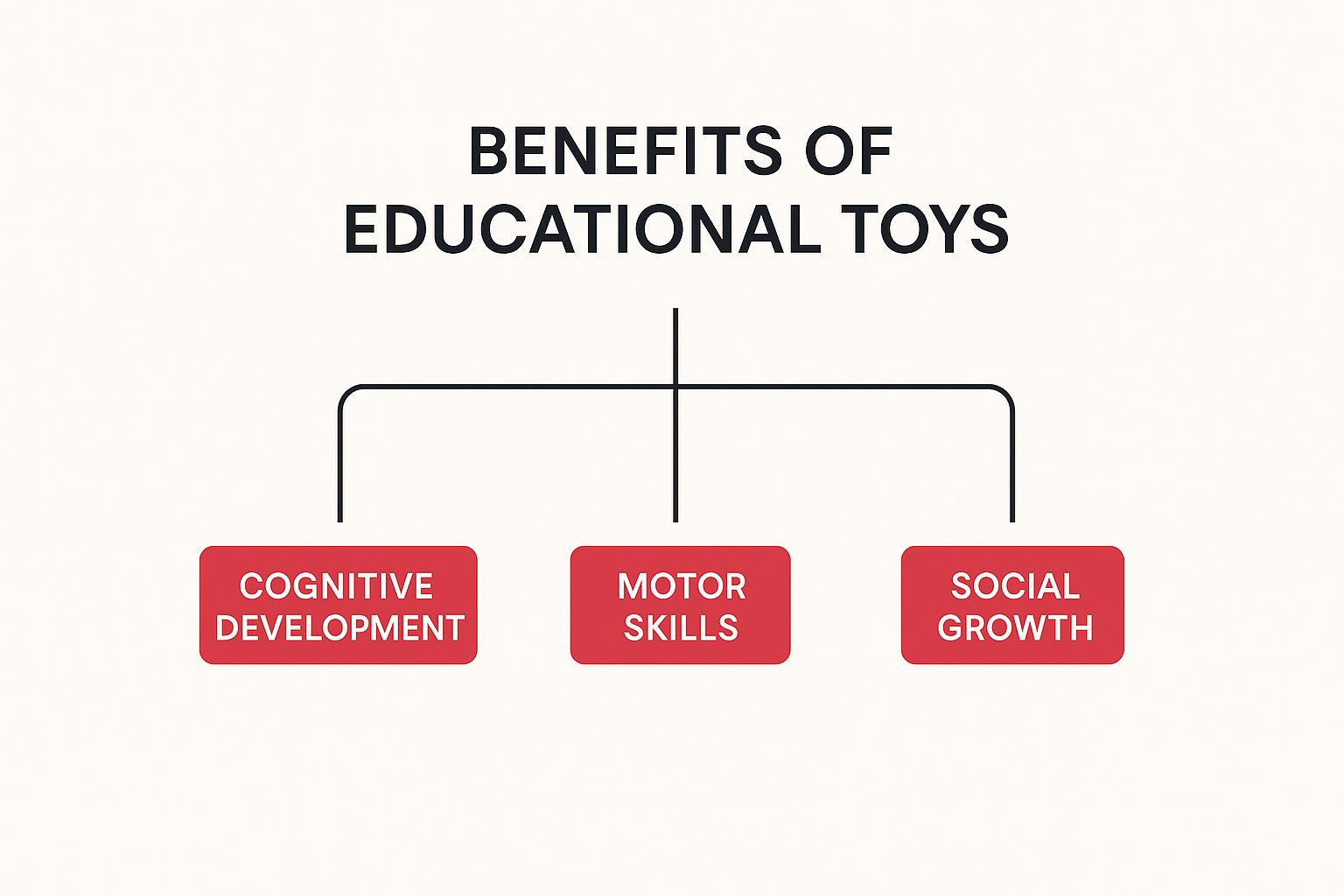
This shows how a single, well-chosen toy can support cognitive, motor, and social-emotional skills simultaneously, offering a truly holistic developmental boost.
To help you spot these opportunities, here’s a quick breakdown of what these developmental areas look like in action.
Key Developmental Areas Targeted by Educational Toys
| Developmental Area | What It Looks Like In Play | Practical Toy Example |
|---|---|---|
| Cognitive Skills | Problem-solving, cause-and-effect, memory. | Puzzles, shape sorters, basic science kits. |
| Fine Motor Skills | Stacking, threading, buttoning, drawing. | Building blocks, lacing beads, art supplies like crayons. |
| Gross Motor Skills | Pushing, pulling, balancing, climbing. | Push-pull toys, small ride-on toys, balls. |
| Social-Emotional | Sharing, taking turns, expressing feelings. | Play kitchens, dolls, collaborative building sets. |
| Language & Communication | Naming objects, telling stories, asking questions. | Puppets, picture books, imaginative play sets. |
Each of these skills is like a muscle—the more it's used, the stronger it gets. The best educational toys for preschoolers provide a fun "workout" without the child ever realizing they're learning.
Why Choosing the Right Educational Toy Matters
The global educational toys market was valued at USD 54 billion in 2023 and is expected to more than double by 2030. This massive demand makes choosing wisely even more crucial. What's telling is that children aged 1-3 years old made up 51% of this market, showing a huge focus on early development.
Key Takeaway: The true value of an educational toy isn't measured by its features, but by the number of questions it inspires a child to ask. It's about sparking curiosity, not just providing answers.
Ultimately, a toy becomes a learning tool when it empowers a child to think for themselves. It should be a partner on their journey of discovery, offering new challenges and worlds to create. By focusing on toys that ignite creativity, you’re giving them the building blocks for a lifetime of learning.
Matching Toys to Your Preschooler's Milestones
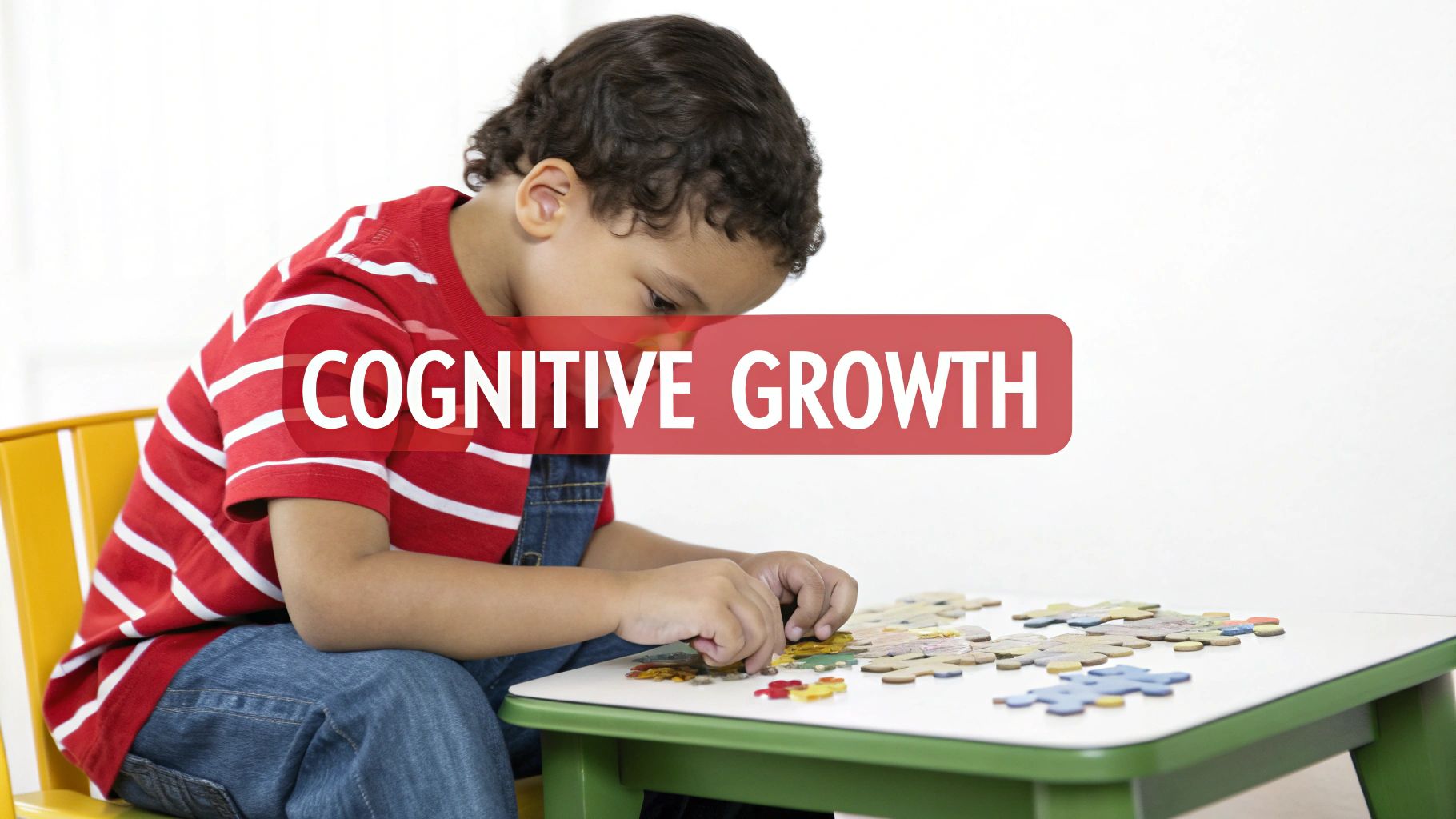
Choosing the best educational toys for preschoolers isn't just about grabbing something colorful off the shelf. It’s about being a matchmaker, pairing the right toy with your child’s specific developmental stage. Think of it like a gardener: you provide the right nutrients at the right time to help a plant flourish.
That’s what the best toys do. They meet your preschooler where they are, nurturing the skills that are just starting to sprout. A classic set of stacking rings isn't just a toy; for a young child, it's a hands-on masterclass in cause-and-effect, problem-solving, and hand-eye coordination.
Fueling Cognitive Growth and Problem-Solving
Cognitive skills are the brain's heavy lifters—covering everything from reasoning to memory. Toys that get these mental gears turning are crucial for building a solid foundation for all future learning.
- Puzzles: As your child twists and turns pieces to find the right fit, they’re learning about spatial relationships and pattern recognition. More importantly, they’re training their brain to stick with a challenge. It's perseverance in a box.
- Memory Games: These are fantastic for sharpening focus and recall in a fun, low-stakes way.
- Sorting & Matching Toys: Grouping objects by color, shape, or size teaches classification—a fundamental math skill.
For more ideas tailored to this crucial age, our guide to the best educational toys for 3-year-olds is a great next step.
Actionable Insight: A puzzle isn't just about finding the right fit; it's about teaching a child that with patience and strategy, every problem has a solution. It builds resilience one piece at a time.
This kind of play develops executive function skills: the ability to plan, focus, and juggle tasks. These are the mental tools they’ll rely on for life, and the training starts right here on the playroom floor.
Building Fine and Gross Motor Skill Mastery
Motor skills fall into two camps: fine motor skills (small, precise hand movements) and gross motor skills (large muscle movements). Great toys support both.
Toys that build fine motor control include:
- Building blocks: The steady hand required to place one block on another without it toppling is pure hand-eye coordination.
- Art supplies: Gripping a crayon, guiding a paintbrush, or squeezing a glue bottle all strengthen the tiny muscles needed for writing.
- Modeling clay: All that squishing, rolling, and shaping is an incredible workout for little fingers.
On the flip side, toys that boost gross motor skills get kids moving. Think push toys, balls, and ride-on toys that help them master balance, coordination, and physical confidence.
Nurturing Social and Emotional Learning (SEL)
For preschoolers, playtime is social studies class. It's their first lab for navigating relationships, understanding big feelings, and working together.
Imaginative play sets are goldmines for this. A pretend kitchen is more than a toy; it’s a stage where kids practice sharing, take turns, and try on different social roles. This role-playing is how they process the world. When they pretend to be a doctor healing a patient, they’re literally walking in someone else’s shoes and building the foundations of empathy and emotional intelligence.
Expanding Language and Communication Skills
Every playtime interaction is a language lesson in disguise. The best toys for communication get the stories flowing and conversations started.
- Real-World Example: A shy child might suddenly find their voice through a silly sock puppet, using it to share ideas and tell elaborate stories.
- Picture books and alphabet toys: As you play together, you can name objects, ask open-ended questions like, "What do you think the dragon will do next?", and slip new words into the conversation.
This back-and-forth dialogue is infinitely more powerful than any app because it’s real, responsive, and full of connection.
How to Choose the Right Educational Toys for Your Preschooler
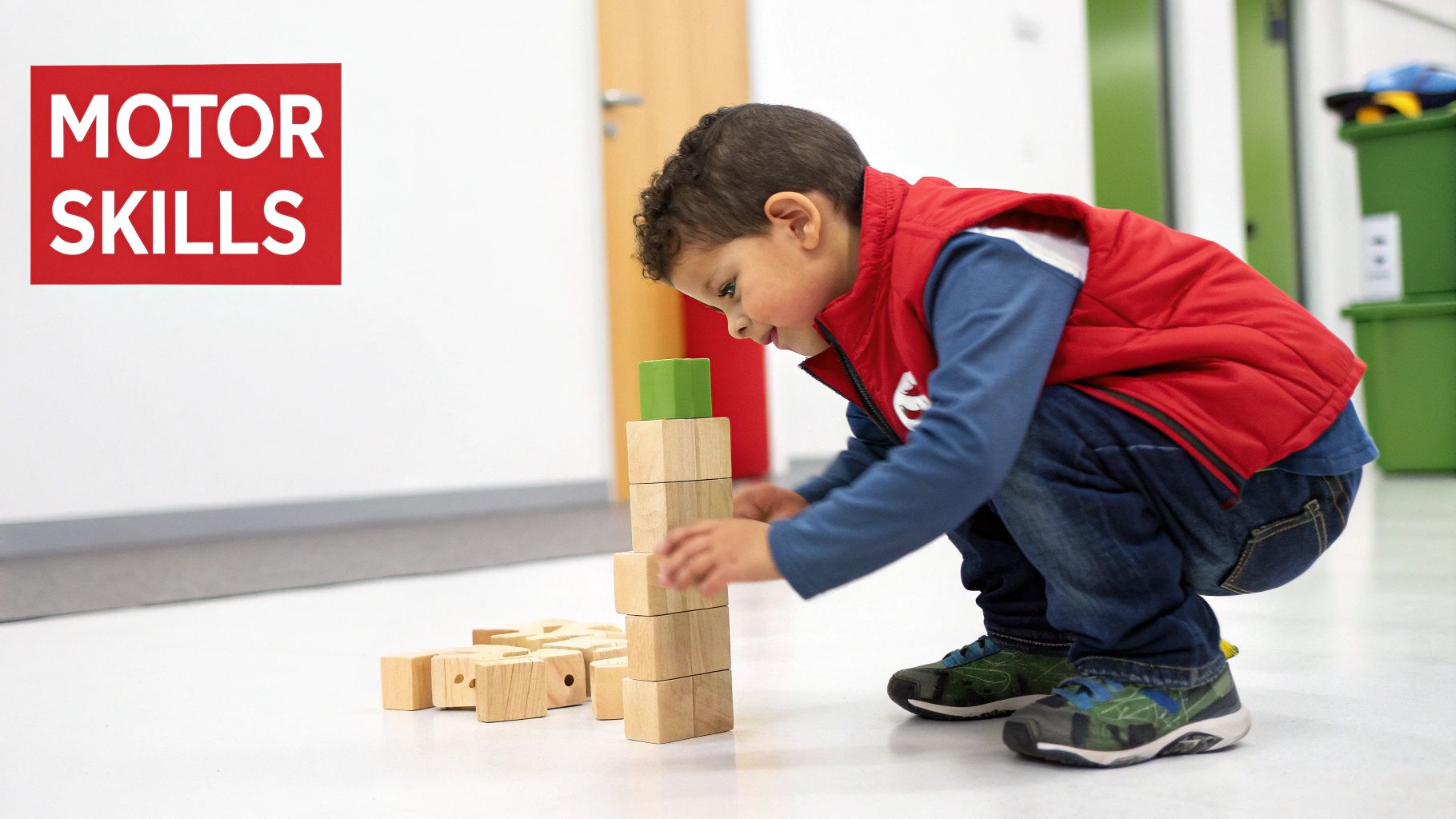
Walking into the toy aisle can be overwhelming. You’re hit with a wall of bright colors, each box promising to make your child a genius. The secret isn't grabbing the fanciest packaging but finding toys that will stick around—the ones that capture your child’s imagination for more than five minutes.
To find those gems, you first need to understand the difference between two kinds of toys: one is a blank canvas, the other is a paint-by-number kit.
Open-Ended vs. Close-Ended Play: A Quick Comparison
The most valuable educational toys are almost always open-ended. This means they don't have a single, pre-determined way to be used. They’re powered by imagination. A simple set of wooden blocks doesn't tell a child what to do. One day they're a towering castle; the next, they're a spaceship.
Close-ended toys have a specific goal. Think of a puzzle with one correct solution or an electronic toy that plays a specific song. They’re fantastic for teaching targeted skills, but once the skill is mastered, the toy’s job is done.
| Toy Type | Pros | Cons |
|---|---|---|
| Open-Ended Toys | Encourages creativity, grows with the child, promotes problem-solving. | Can be less structured, may require more adult engagement initially. |
| Close-Ended Toys | Teaches specific skills, provides clear goals and sense of accomplishment. | Limited replay value, can be mastered quickly. |
A great toy box has a mix of both, but leaning into open-ended toys gives you far more mileage. For a deeper look into toys that build critical thinking, check out our guide on STEM toys for kids.
Prioritize Safety and Durability Above All Else
Before any toy can be a tool for learning, it has to be safe. For preschoolers, this is non-negotiable. Always check for potential hazards and ensure it’s built to survive enthusiastic play.
Key Safety Checks
- Non-Toxic Materials: Look for labels stating the toy is made from non-toxic, BPA-free, and phthalate-free materials. This is crucial, as little ones often explore with their mouths.
- No Small Parts: For children under three, watch for choking hazards. The toilet paper roll test is a great rule of thumb: if a piece fits inside, it’s too small.
- Durable Construction: A well-made toy can handle being dropped and tossed. Look for solid wood, thick plastic, and reinforced seams.
Key Takeaway: A toy that breaks easily isn't just a waste of money—it can create sharp edges and dangerous small parts. Investing in durability is an investment in your child's safety.
Match the Toy to Your Child's Interests
The "best" educational toy in the world is useless if your child isn't interested in it. The most successful toys tap into your preschooler's unique personality and current obsessions. Pay attention to what they naturally gravitate toward.
- For the Builder: Lean into construction sets and blocks.
- For the Storyteller: Puppets or imaginative play sets are a perfect fit.
- For the Thinker: Puzzles and simple logic games will be a huge hit.
When you choose toys based on their natural interests, learning feels like pure fun. That personal connection is the magic ingredient that turns an object into a beloved tool for discovery.
Our Top Picks for Educational Toy Categories
Now that you know how to spot a genuinely educational toy, let's talk about the MVPs. These are the categories that consistently deliver the biggest developmental bang for your buck. Think of this as your curated shortlist of tried-and-true classics that experts and parents swear by.
The market for these tools is exploding. Valued at USD 60.77 billion in 2024, the infant and preschool educational toy segment is projected to soar to USD 105.38 billion by 2031, with a huge shift toward hands-on learning with things like STEM kits and puzzles.
Building and Construction Toys
This category is the undisputed champion of open-ended play. We're talking about classics like wooden blocks, Magna-Tiles, or LEGO DUPLO bricks—the foundation of early STEM learning. When a child stacks blocks, they’re secretly experimenting with gravity, balance, and geometry. Every time a tower tumbles, they learn about cause and effect.
These toys are powerhouses for building crucial skills:
- Spatial Reasoning: Figuring out how shapes fit together in 3D space.
- Problem-Solving: "How do I build a bridge that won't fall?"
- Fine Motor Skills: Precisely placing pieces is a fantastic workout for hand-eye coordination.
A good set of blocks is a long-term investment. A two-year-old will use them for stacking, while a five-year-old will construct entire cities. They grow with your child.
Arts and Crafts Supplies
Creativity isn't about making a perfect project; it's about self-expression, messy experimentation, and sensory exploration. Supplies like modeling clay, finger paints, crayons, and safety scissors are some of the most versatile educational tools. These materials are fantastic for developing the fine motor control needed for writing. Plus, art gives preschoolers a safe outlet to express big emotions they might not have words for yet.
Key Takeaway: Art isn't the outcome. It's the process. It's the messy, joyful discovery of what happens when you mix blue and yellow.
Puzzles and Logic Games
Puzzles are the original brain-trainers for preschoolers. They teach patience, persistence, and the amazing feeling of satisfaction when a problem is solved. From simple peg puzzles to sprawling floor puzzles, these toys are masters at teaching pattern recognition and logical thinking. Completing a puzzle forces a child to analyze shapes, plan their next move, and change their strategy when a piece doesn't fit, quietly building resilience.
Pretend Play Sets
Imaginative play is how children process their world. Pretend play sets—like a play kitchen, a doctor kit, or dress-up clothes—are the props they need to act out social situations, practice empathy, and grow their vocabulary. When kids play "house" or "school," they explore social roles and learn cooperation and negotiation. This kind of play is also a language explosion waiting to happen, building the bedrock skills for emotional intelligence.
Want to dive deeper? Check out our guide on the best toys for imaginative play and see how it fuels development.
How Technology is Shaping Preschool Play
Technology is in every corner of our lives, and the toy box is no exception. This shift brings both exciting possibilities and important questions for parents. The best educational toys have always been interactive, but technology adds a new layer. Instead of just reacting to a button push, some modern toys can now listen, adapt, and respond in intelligent ways.
The Rise of Smart Toys and Adaptive Learning
This move toward smarter play is a huge market driver. The global K-12 instructive toy market, valued at USD 71.38 billion in 2024, is projected to hit USD 173.70 billion by 2034. A big slice of this growth comes from AI-powered toys offering personalized learning.
- Adaptive Learning: An app might notice your child is struggling with the letter "B" and serve up more games focused on that sound.
- Interactive Storytelling: A smart speaker can create choose-your-own-adventure stories where your child's decisions change the plot.
- Personalized Feedback: Coding robots can give immediate feedback, helping a child learn from mistakes without getting frustrated.
These toys can be powerful supplements, offering guided play that feels personal and responsive.
Finding a Healthy Balance with Screen Time
We can't talk about tech without addressing screen time. While tech toys offer unique benefits, they should never replace the hands-on, unplugged play that is vital for a preschooler’s development.
Actionable Insight: Technology in toys should be a spice, not the main ingredient. Its purpose is to add a new flavor to play, not to overwhelm the essential experience of hands-on discovery and real-world interaction.
The most important developmental work happens away from screens. Building a wobbly tower with wooden blocks teaches physics in a way no app can. For practical advice, our guide on how to limit screen time offers helpful strategies. The goal is a healthy equilibrium, treating technology as just one of many valuable resources in your child’s learning toolkit.
How to Create a Playful Learning Environment at Home
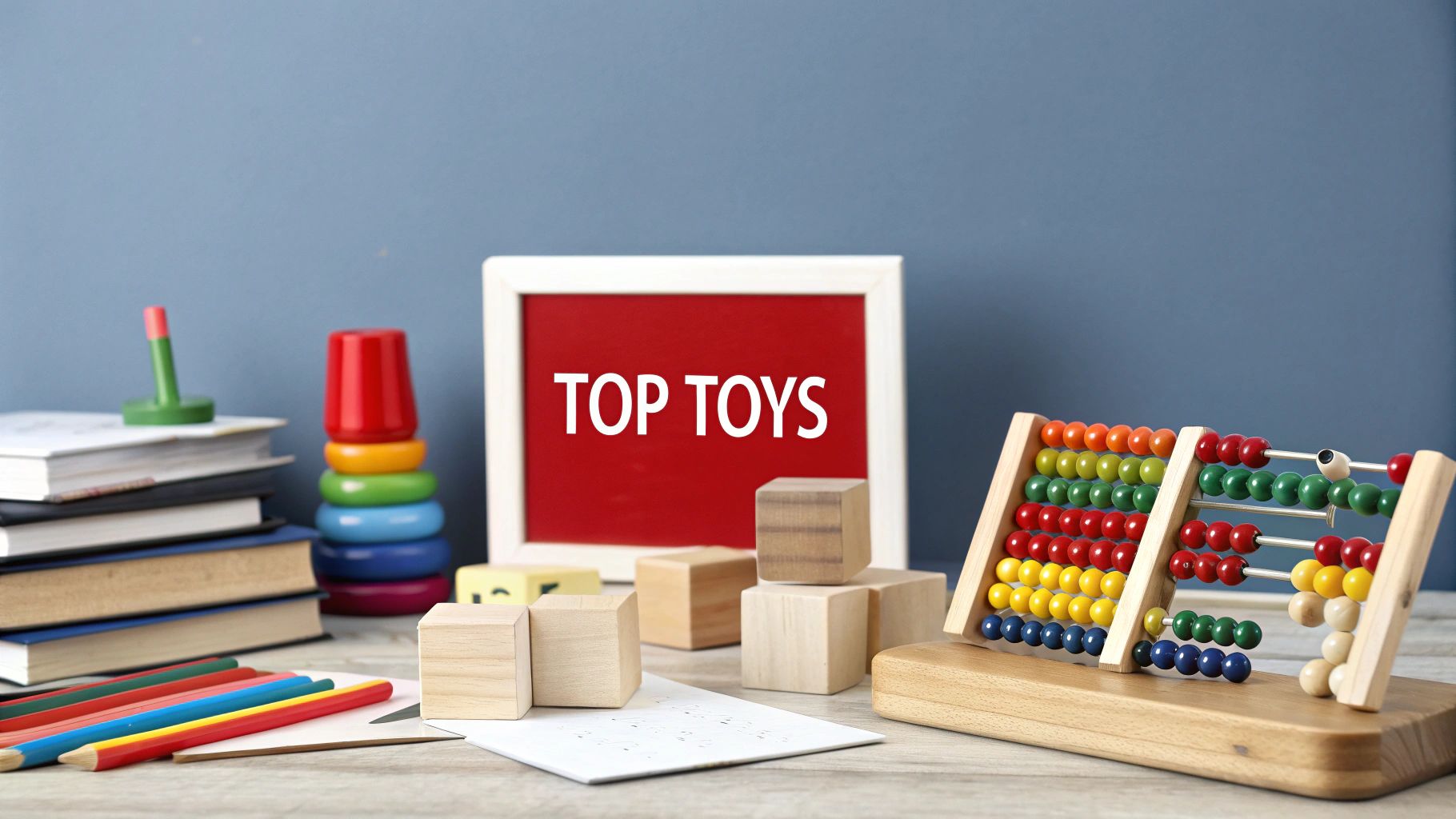
Even the best educational toy needs the right stage to shine. A thoughtfully designed play area becomes a silent partner in your child's learning, sparking curiosity and inviting exploration. This isn't about having a Pinterest-perfect playroom—it’s about creating a space where discovery happens naturally.
Setting the Stage for Independent Discovery
Making toys easy to see and reach is a game-changer. When everything is stored in open, low-level bins or on shelves, your preschooler can make their own choices, building independence and confidence. Another powerful strategy is toy rotation. Instead of overwhelming them with every toy, keep a smaller selection out and swap them every week or two. This keeps things feeling fresh and cuts down on clutter.
The Power of Asking Open-Ended Questions
Your engagement is the secret sauce that elevates playtime. One of the best ways to participate is by asking open-ended questions—the kind that can’t be answered with a simple “yes” or “no.”
Instead of, "Is that a blue block?" try one of these conversation starters:
- "Tell me about what you're building."
- "What do you think will happen if we add another block on top?"
- "I wonder what this little character is thinking right now."
- "How did you come up with that amazing idea?"
Actionable Insight: This kind of questioning does more than just build vocabulary. It shows your child that their ideas matter, turning a simple activity into a collaborative adventure and building their confidence piece by piece.
Learning Beyond the Toy Box: Everyday Objects
Some of the best learning tools won't be found in a toy store. Look around your house! Everyday items are waiting to be turned into something incredible.
- Real-World Example: A cardboard box can be a rocket ship, a secret fort, or a robot costume. Pots, pans, and wooden spoons? A world-class drum set. A pile of blankets and pillows? A cozy cave perfect for storytelling.
This proves you don't need a huge budget to foster a rich learning environment. It’s about seeing the potential for play in the world around you and empowering your child to do the same.
Frequently Asked Questions (FAQs) About Educational Toys
Navigating the toy aisle can be tricky. Let's clear up some common questions so you can feel confident in your choices.
How many educational toys does my preschooler actually need?
Honestly, less is more. It's tempting to think more toys mean more learning, but the opposite is often true. A small, carefully chosen collection of open-ended toys—like building blocks, art supplies, or puzzles—offers far more developmental value than a room overflowing with single-purpose gadgets. Using a toy rotation strategy keeps a small selection feeling fresh and encourages deeper, more creative play.
Do more expensive toys mean they're better for learning?
Absolutely not. The educational value of a toy has nothing to do with its price and everything to do with its ability to spark imagination. Some of the best learning tools are the simplest and most affordable: wooden blocks, play-doh, and even a cardboard box offer limitless opportunities for creativity.
Key Takeaway: The best investment isn't the toy with the biggest price tag, but the one with the most play potential. Always prioritize durability and open-ended design over flashy features.
What's the difference between "Educational" and "STEM" toys?
This is a great question. Think of "educational" as the broad category and "STEM" as a specific sub-category within it.
- Educational Toys: This is the umbrella term for any toy that helps a child learn any skill, from a doll that teaches social-emotional skills to alphabet blocks that build literacy.
- STEM Toys: This is a specific label for toys designed to build skills in Science, Technology, Engineering, and Math. They’re all about encouraging experimentation and a "how does this work?" mindset.
A preschool STEM toy could be a magnetic building set or a simple marble run. So, remember: every STEM toy is educational, but not every educational toy is a STEM toy.
At Playz, we believe learning is the greatest adventure. Our kits are built to turn your playroom into a hands-on lab of discovery, sparking natural curiosity and building the confidence to ask big questions.
Ready to get building? Explore our collection of awesome, hands-on toys today!
